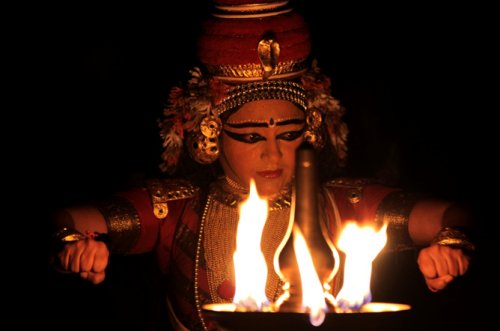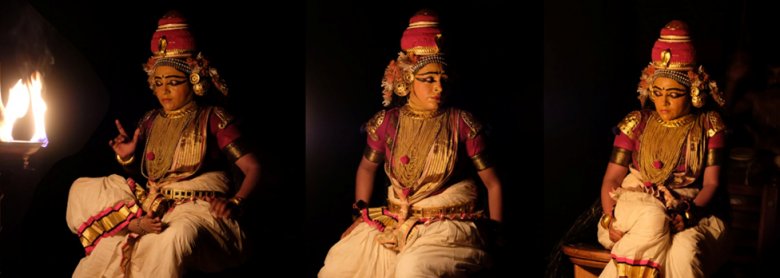
|   |

|   |
Eyes that see, eyes that show - Ranjini Nair e-mail: ran93jini@gmail.com June 11, 2019 Twilight has fallen, the sky an inky blue, the silhouette of the few trees next to Kalam theatre are still, as though even the wind is holding its breath this evening. A single oil lamp almost five feet in height is the only source of light, casting shadows that leap around the theatre in anticipation. The stage has been set for Nangiarkoothu by Kapila Venu, who apart from being an incredible performer of the ancient classical theatre of Koodiyattam, is also the daughter of G Venu, a multi-hyphenate personality - a performer, researcher, pedagogue and writer on India's traditional performing arts. He has also developed the performer-training technique, known as Navarasa Sadhana, which utilises the Kodangalloor theatre training techniques, alongside select exercises that are modified and borrowed from the Koodiyattam tradition. The 23rd edition of the workshop was underway at Natanakairali, in the temple town of Irinjalakuda, and Kapila Venu's performance had been organised specially keeping in mind the participants of the workshop. As one walks into the traditional theatre space, with its thatched roof, rafters made of bamboo and palm trees, and cow-dung floor, the smell of incense clings to the air. As we wait for the performance to begin one can hear an orchestra of crickets and frogs, the usual music of nights in Kerala. Two more wicks are added to the oil lamp, and lit, signalling the beginning of the performance, and one mizhavu player comes on stage beating a sonorous rhythm, which seems to ricochet off one's body with each beat. As he stops, G Venu comes onto stage to introduce the piece, as well as the accompanying artists for the evening. The piece, Kamsavadham is a rare portion in Nangiarkoothu which portrays all the navarasas from sringaram to santham. Perhaps it is imagined, but a ripple of excitement spreads through the audience, especially the participants from the workshop, who had been working for the past two weeks on evoking the nine rasas as a sadhana, or ritual practice. He tells us that in this piece it is important to take note of the karuna rasa, which is evoked in Devaki's reaction to seeing Krishna after sixteen years. She, who hasn't seen her son since the day she gave birth to him, finally sees him on a day when his death seems imminent, and love and fear entangle themselves as she lays eyes on him. The orchestra positions itself on stage, and as the beats of the mizhavu and edakka rise in tempo, two stage attendants walk in, holding a rectangular white and red curtain which screens the performer from the audience's view. Only her feet are visible, above which the white costume bordered with red and gold fans out. A conch blows thrice, and the curtain is dropped to reveal Kapila, her eyebrows dancing, looking like a bird in flight, and one is already mesmerized. She offers her salutation to those present, and sits on the stool, a familiar prop of this ancient theatre. The studied languor of her hand gestures is minutely evocative, as though she is using a language that is familiar to us all. I am delighted to recognise the gesture for "at that time", something we have learnt within the workshop space. It feels as though my mind is attempting to comprehend a language that it has just learnt, and now wants to put to practice. The scene opens with Kamsa learning of Krishna having broken his sacred bow, as well as having killed the mightiest elephant, Kuvalayapeeda. As Kapila mimes the bow, one can feel it materialise before one's eyes, the weight, the texture, its import for Kamsa, all conveyed through the movement of the hands, and most importantly, the eyes. The tusks of the elephant also seem to appear within her hands, and for an evanescent moment, I am convinced that I can see it.  The piece evokes the navarasas by way of different reactions to Krishna's presence in Mathura to kill the tyrant Kamsa. The wrestlers in Mathura, Kamsa's henchmen, evoke raudram and with deft flicks of her wrist, as well as a specific turning in on of the fingers into a mushti-like gesture, her face and hands imply and capture vividly the intention of the wrestlers to beat him to pulp. The act moves into adhbutam, and here the quality of breath of the performer is what metaphorically takes one's breath away. One can feel the wonder in her breath, and the importance stressed by G Venu within the workshop becomes apparent to me. Tears glisten in her eyes, and the movement of her upper torso with her breath, accompanied by the movement of her eyes following Krishna walking through the streets, and the description of his body through her eyes alone, mark her consummate skill to involve the audience into her imagination of the scene. Small, delicate and precise movements convey the immense sringar that Krishna is known to ignite in hearts.The desire felt almost palpable within her eyes as they trailed after Krishna, unable to look away from him, he who looks like Kamadeva incarnate. One of my favourite scenes is the one which depicts hasyam, as the cowherds who have accompanied Krishna from Vrindavan look at how others are looking at their Krishna and wonder what it is that they see in him. The slight envy which colours this gaze is one that was subtly evoked by Kapila to great effect. The karuna rasa is beautifully brought out, and it seems as though Krishna is actually present before her. She hugs him as though she is unable to get enough of him against her chest, and it is an image which remains with us long after the performance ends. The milk that flows from her breasts on seeing Krishna, is a wonderfully poetic image that similarly conveyed the long years of separation that she has endured. It almost seems as though time has stood still for her since Krishna was taken away. The transition from that boundless love to sorrow is heart-rending, and the tears that stream down Kapila's face stand as testimony to the deep involvement of the artist, which in turn transports the audience into that mythic realm.  Another pivotal scene is of bhayanakam, where the ease with which she establishes that Kamsa is sitting in a high tower, just through her eyes, is unbelievable. The illusion of seeing from a great height is brought out as Kamsa opens the window to look down at Krishna running through the streets towards him. Her eyes fill with fear, drop by drop it seems, and this causes him to shut the window on the scene. As paranoia sets in, Kamsa feels like he can hear his death approaching and each sound makes him afraid, and he replays the scene of the breaking of the bow, and the elephant's tusks and is terrified as to what will become of him. In the workshop, our day begins with eye exercises from the Koodiyattam and Kodangallor traditions. It is on viewing this scene in particular that the importance of those exercises, and how ingeniously they can be put to use reveals itself to spellbinding effect. The final sequence has Kapila mime jumping on to the seventh floor where Kamsa hides, by jumping onto the stool. There was a particular moment that Krishna would kill Kamsa like a lion hunts his prey which was sublime, equal parts terrifying and equal parts filled with valour. After she kills Kamsa in graphic detail, mimed through her hands, facial expressions and eye movements, there is a point where she wonders whether to cause Kamsa more pain but decides against it, which I found incredibly moving. The gradual transition from the great gravity of having killed Kamsa to a joyous dance of celebration was cathartic to view. This performance will remain etched in my memory for all time to come, as it brought alive for me how Venu sir reminds us each day that the eyes in performance have a dual function. The eyes not only see the imagined image, but also show that image to the audience, and it is in that moment that the story within the performance comes to life. Seated before the stage bathed in the dancing flames of the lamp, which became almost a part of the scene, I was privy to a spectacle wherein the rasas evoked seemed to have a fathomless depth. I feel ready to dive in again and again. Ranjini Nair is a dancer at the Kuchipudi Dance Academy, New Delhi |